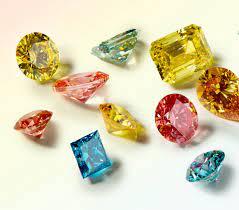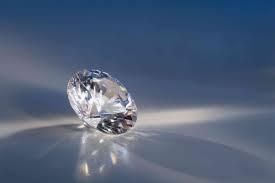Diamonds have long been revered as one of the most precious and desirable gemstones in the world. However, with their high value and iconic status comes a fair amount of mythology and misconceptions. From their rarity to their indestructibility, many of the beliefs surrounding diamonds are simply not true.
There are some myths surrounding the diamonds and IIG is busting these myths here for you. We aim to debunk some of the most common diamond myths and provide you with a better understanding of these dazzling diamonds. Whether you’re shopping for an engagement ring or simply interested in learning more about diamonds, read on to discover the truth behind the myths.
# 1 DIAMONDS ARE FOUND ON EARTH
There are many planets and sub–planets in the universe. These planets have their kind of minerals yet to be discovered. Scientists have discovered diamonds on Uranus and Neptune along with many gemstones. They discovered that lightning storms turn methane into carbon so it rains diamonds.
# 2 DIAMONDS ARE INDESTRUCTIBLE
Diamonds are known for their hardness and durability but are not indestructible. Diamonds can be damaged or destroyed if they are not properly cared for or exposed to extreme conditions. For example, high temperatures can cause a diamond to crack or chip. Additionally, diamonds can scratch or chip other materials if they are not stored separately.
Proper care and maintenance are crucial to ensuring the longevity and beauty of a diamond. This includes regular cleanings, storing the diamond separately from other jewellery, and avoiding exposing the diamond to extreme conditions.
# 3 DIAMONDS ARE RARE AND VALUABLE
Diamonds have earned their reputation as the ultimate symbol of luxury and love. However, the belief that diamonds are rare and valuable is a common misconception. In reality, diamonds are not as rare as you may think. In fact, diamonds are one of the most abundant gemstones on Earth. So why are they so expensive? The answer lies in the way diamond prices are determined. The diamond industry controls the supply of diamonds. Additionally, the perceived value of diamonds is heavily influenced by effective marketing campaigns.
# 4 THE 4 CS ARE THE ONLY FACTORS THAT MATTER
The 4 Cs, which stand for carat weight, colour, clarity, and cut, are often considered the most important characteristics of a diamond. However, there are other factors that can significantly impact a diamond’s appearance and value. For example, fluorescence, symmetry, and polish can all affect a diamond’s appearance and should be considered when choosing a diamond.

# 5 ONLY WHITE DIAMONDS ARE EXPENSIVE
Diamonds are found in many colours in nature. The rare colour of diamonds determines the value of the diamond. Rarer the colour the more expensive they are.
# 6 THE BIGGER, THE BETTER
The belief that the bigger the diamond, the better it is, is a common myth. While carat weight is an important factor in diamond pricing, it is not the most important factor in determining a diamond’s beauty and value. Other characteristics such as color, clarity, and cut can significantly impact a diamond’s appearance. In fact, a well-cut diamond with high clarity and colour can appear larger than a diamond of the same carat weight but with poorer quality characteristics.
# 7 DIAMONDS ARE CONFLICT-FREE
The belief that all diamonds are conflict-free is a myth. Conflict diamonds, also known as blood diamonds, are diamonds that are mined in war zones and sold to fund conflict. The Kimberley Process Certification Scheme was established in 2003 to prevent conflict diamonds from entering the diamond supply chain.
For those concerned about ethical diamond sourcing, alternative options are available. Lab-grown diamonds and alternative gemstones, such as moissanite and cubic zirconia, can be ethical and stunning alternatives to mined diamonds.
# 8 LAB-GROWN DIAMONDS ARE NOT REAL DIAMONDS
Lab-grown diamonds are not fake diamonds. They are chemically identical to natural diamonds, they exhibit the same optical and chemical properties. Mined diamonds often have slight traces of nitrogen, which are missing in lab diamonds. Lab-grown diamonds are less valuable than natural diamonds and also less rare. The term synthetic cannot be applied to lab-grown diamonds because they are made from pure carbon, the same material natural diamonds are made of. The main difference is that lab-grown diamonds are created in a laboratory (i.e. man-made) whereas a real diamond is mined from the earth.
# 9 DIAMONDS ARE NOT A GOOD INVESTMENT AND HAVE NO RESALE VALUE
Diamonds are durable and last a lifetime with proper care. They appreciate over time, making them a smart investment for the future. Diamonds have appreciated up to 40% over the decades since it was first found.
# 10 DIAMONDS ARE ONLY FOR ENGAGEMENTS AND WEDDINGS
While diamonds are often associated with engagements and weddings, they can be worn and styled in a variety of ways. Diamonds can be incorporated into daily wear; such as diamond stud earrings or a delicate diamond pendant necklace. Additionally, diamonds can be a stunning addition to formal evening wear or even casual and bohemian outfits.

Diamonds have a rich history and symbolism and can be a meaningful and versatile addition to any jewellery collection. If you prefer natural or lab-grown diamonds, large or small, it is important to choose a diamond that speaks to you and your unique style.
By understanding the truth about diamonds, you can make an informed decision when it comes to purchasing or wearing these precious stones. You can join our Programs like Masters in Diamonds and Diamond Graduate to learn in-depth about diamonds and begin your career with us.
Visit the fastest-growing premier Education Institute of the Gems and Jewellery Industry at our pan-India locations including Mumbai & Surat.
We are easily accessible on Instagram, Facebook, LinkedIn and Twitter @iigofficial.
Author:- Charmi Soni Shroff
Being a part of the Gems & Jewellery industry for the last 15 years I garnered insights into gems, diamonds and jewellery. I have authored a handbook on casting techniques and various blogs on various methods of healing and meditation with gemstones. Presently working with IIG Mumbai as a writer, author, external spokesperson and PR representative.

